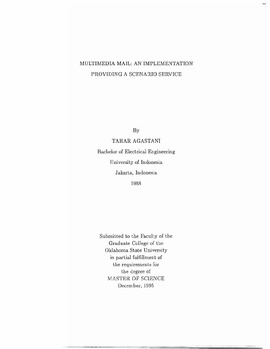| dc.description.abstract | Multimedia systems suggest a wide variety of potential applications. One of the important applications already in use is multimedia electronic mail (multimedia mail). This distributed multimedia application extends the widely accepted electronic mail (e-mail) to include various types of data such as text, still image, graphic, audio, and video. The most services provided by an electronic mail, even a multimedia mail is "passive" in the sense that data are unidirectional [Bor94]. Mail messages that contain text, image, sound, or video are simply displayed to the user. The less commonly used has been an "active" mail. In the active mail, a message contains a program to be executed when the recipient reads the message. The program, for example can be created to display message in a certain way. Conceptually, the general model for the introduction of computational power in e-mail systems called Enable Mail has been proposed in [RB94] . The active mail can be useful to add or improve services in multimedia mail. The scenario service [KGH94], is actually the example of the active mail implementation to improve messaging service. This service provides a scenario in the form of code (program) included in a message to be interpreted when the recipient reads the message. Kervella et al. [KGH94] proposed the scenario service in the multimedia mail system based on XAOO standard which is a CCITT standard for message handling system. The service allows the sender to coordinate the message body parts (the parts of message body) it sends and to adapt the restitution of the message depending on the media the receiver workstation can restore. This is the main element necessary for the good development of the multimedia mail. We propose a new scheme for scenario service to be implemented in the messaging system that support MIME (Multipurpose Internet Mail Extension) [BF93]. MIME is the format standard for multimedia mail that widely used in the internet community. The Rand Message Handling System (MH) is used as a user agent for this implementation. We develop a user interface that is capable of composing multimedia message, creating the scenario for that message, sending and presenting the message. | |
